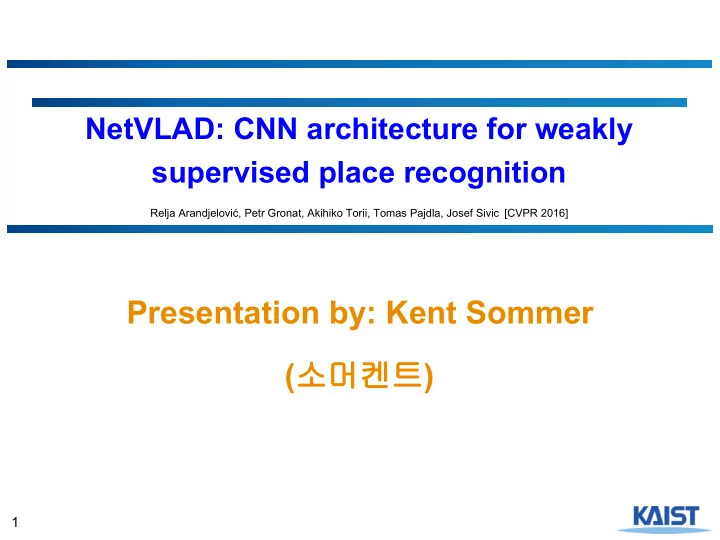

NetVLAD: CNN architecture for weakly supervised place recognition Relja Arandjelović, Petr Gronat, Akihiko Torii, Tomas Pajdla, Josef Sivic [CVPR 2016] Presentation by: Kent Sommer ( 소머켄트 ) 1
Outline 1. Review / related work 2. Overview of approach 3. Issues with approach 4. Results 5. Conclusions and Quiz! 2
Visual Place Recognition ● Has gained lots of attention recently ○ Computer Vision and Robotics Communities ○ Useful for: ■ Localization for many autonomous robotic tasks ■ Localizing old images (no geo-tags available) ● Usually viewed as an instance retrieval task ○ Some query image location is estimated by matching the most similar images in a database with images of known location 3
Visual Place Recognition ● Challenges: ○ Appearance changes ■ Seasonal / weather ■ Lighting ■ Occlusions (construction, cars, trees, etc.) Images source: http://www.di.ens.fr/willow/research/netvlad/ 4
Visual Place Recognition ● Challenges: ○ Viewpoint changes ■ Images can be taken from anywhere Images source: http://www.di.ens.fr/willow/research/netvlad/ 5
Visual Place Recognition ● Challenges: ○ “Big” data ■ Database of images can become unwieldy extremely quickly, how can we scale to world-wide localization? Images source: https://goo.gl/OQRtq1 6
Visual Place Recognition ● Related work: ○ Two main categories: ■ Non-learning based ● Local features (SIFT, ORB, SURF, etc.) ■ Learning based (again two main categories) ● Learning for auxiliary task ○ Ex: distinctiveness of local features ● Learning on top of hand-engineered descriptors (cannot be tuned for target task) 7
Visual Place Recognition Related Work ● City-Scale Location Recognition ○ Partnership between Georgia Tech and Microsoft Research ○ With careful selection of vocabulary and use of a vocab tree -> can increase database size by 10X The tree search algorithm considers the N best nodes at each level (left to right N = 1, 2, 5, 9). Cells are coloured from red to green according to the depth at which they are searched, while gray cells are never searched. Images source: http://matthewalunbrown.com/location/location.html 8
Visual Place Recognition Related Work ● 24/7 place recognition by view synthesis ○ Utilizes view synthesis to render virtual views directly from Google street-view panoramas and associated depth maps ○ Based on intuition that matching with large appearance changes is easier when view is the same Images source: http://www.ok.ctrl.titech.ac.jp/~torii/project/247/ 9
Visual Place Recognition ● Issues with local features ○ Main goal is matching local image patches ○ Not built with image retrieval in mind (not optimized for target goal) ● Issues with CNN features ○ CNN features are treated as black box image descriptor extractors Images source: http://www.di.ens.fr/willow/research/netvlad/ 10
NetVLAD Can an end-to-end CNN help? 11
NetVLAD ● Challenges for approach ○ What does a good end-to-end CNN architecture for place recognition even look like? ○ How can a sufficient amount of training data be gathered for this task? ○ What is an appropriate loss function for end-to-end training? 12
NetVLAD ● What does a good end-to-end CNN architecture for place recognition even look like? ○ New trainable generalized NetVLAD layer based on the Vector of Locally Aggregated Descriptors! ■ Aggregated representation is eventually compressed using PCA to get final descriptor Images source: http://www.di.ens.fr/willow/research/netvlad/ 13
NetVLAD ● What does a good end-to-end CNN architecture for place recognition even look like? Images source: http://www.di.ens.fr/willow/research/netvlad/ 14
NetVLAD ● What does a good end-to-end CNN architecture for place recognition even look like? Images and eq’s source: http://www.di.ens.fr/willow/research/netvlad/ 15
NetVLAD ● How can a sufficient amount of training data be gathered for this task? ○ Collect images of the same place at different viewpoints over time using Google Street View Time Machine ■ Data is available but only weak supervision ● GPS can only give definite negatives not definite positives! Images source: http://www.di.ens.fr/willow/research/netvlad/ 16
NetVLAD ● What is an appropriate ranking loss function for end-to-end training? ○ Inspired by triplet loss as in [1] ○ Can be optimized with Stochastic Gradient Descent Equations source: http://www.di.ens.fr/willow/research/netvlad/ [1]: J. Wang, Y. Song, T. Leung, C. Rosenberg, J. Wang, J. Philbin, B. Chen, and Y. Wu. Learning fine-grained image similarity with deep ranking. In CVPR, pages 1386–1393, 2014 17
NetVLAD ● Weaknesses with overall approach ○ Only weakly supervised, so better results would be expected with stronger supervision (manual labor tradeoff) ■ Stronger supervision could be provided through definite positives ○ Uses triplet inspired ranking loss ■ Training is long (all triplets used) ■ Training is not fully representative (subset of dataset) 18
NetVLAD Results ● Datasets tested against ○ Pittsburg [torii et al. 13] ■ Database: 250k images from Street View ■ Queries: 24k images from Street View at other times ○ Tokyo 24/7 [Torii et al. 15] ■ Database: 76k images from Street View ■ Queries: 215 images from mobile phones Day Query Sunset Query Night Query DB Image Images source: http://www.di.ens.fr/willow/research/netvlad/ 19
NetVLAD Results ● State of the art result on all datasets Trained NetVLAD RootSIFT+VLAD+whitening [Torii et al. CVPR’15] Off-the-shelf Max Pooling [Razavian et al. ICLR’15] Graph source: http://www.di.ens.fr/willow/research/netvlad/ 20
NetVLAD Results ● End-to-end training is crucial! Trained NetVLAD Off-the-shelf VLAD Graph source: http://www.di.ens.fr/willow/research/netvlad/ 21
NetVLAD Results ● NetVLAD is significantly better than Max pooling Trained NetVLAD Trained Max pooling Graph source: http://www.di.ens.fr/willow/research/netvlad/ 22
NetVLAD Results ● Tested on related task: image/object retrieval ○ Sets new state-of-the-art for compact image representations (256-D) on all 3 datasets Table and images source: http://www.di.ens.fr/willow/research/netvlad/ 23
NetVLAD ● Conclusions / Summary ○ State-of-the-art on place recognition and image retrieval benchmarks ○ Trainable NetVLAD pooling layer ○ Street View Time Machine ○ Weakly supervised ranking loss Images and eq’s source: http://www.di.ens.fr/willow/research/netvlad/ 24
QUIZ! 1. Why is NetVLAD considered weakly supervised? a. GPS only gives definite negatives b. Uses Soft Assignment c. GPS only gives definite positives d. Uses Triplet Loss 2. What is being done while learning anchor point (Ck) for definite negatives? a. Maximise distance between descriptors b. Minimise angle between descriptors c. Minimise distance between descriptors d. Maximise angle between descriptors “There are 2 hard problems in computer science: caching, naming, and off-by-1 errors” 25
Recommend
More recommend